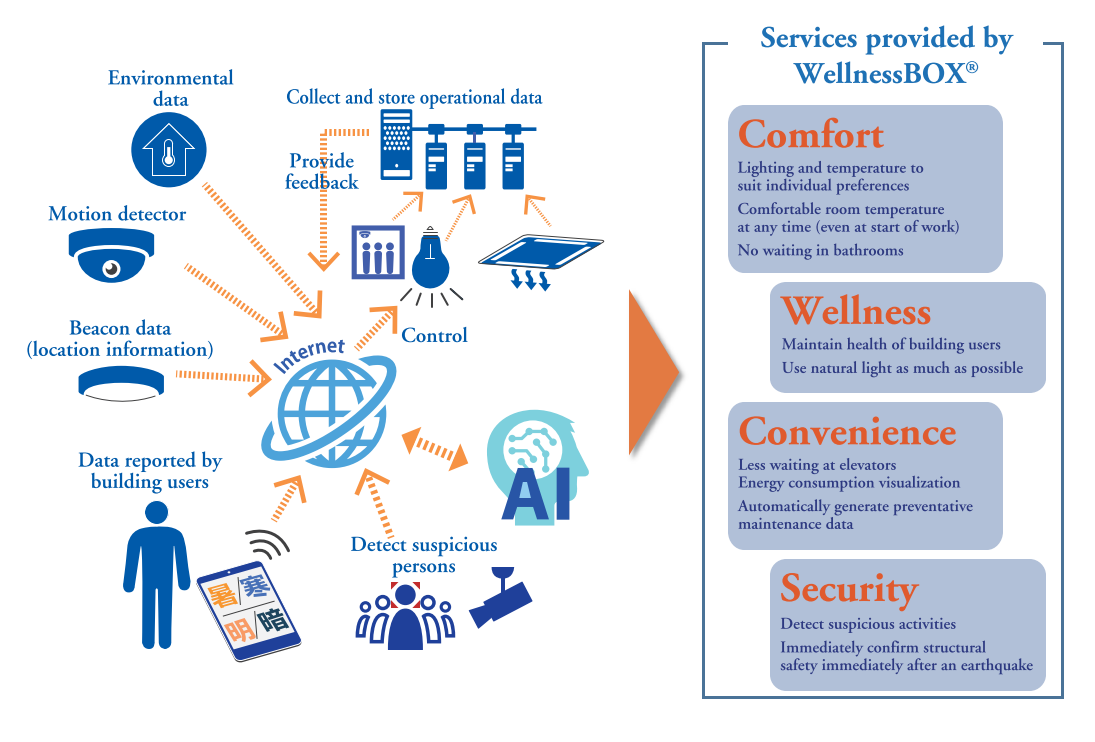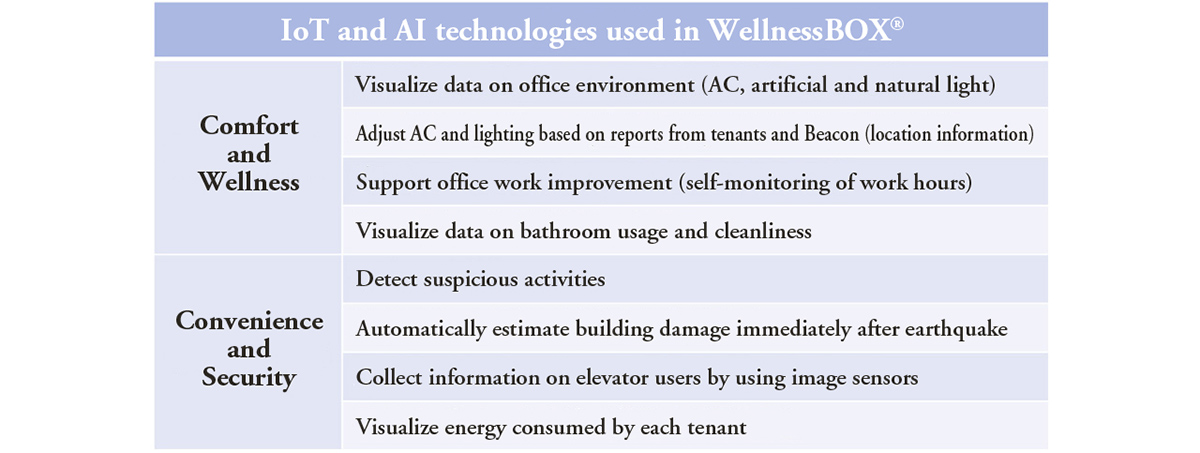- 4 Technology
- Technology Development
WellnessBOX® Enhances Comfort with IoT and AI Technologies
WellnessBOX®, a smart building management system with IoT and AI, was used for the first time in Japan, at a multi-tenant office building in Tokyo.
The system’s effectiveness is proved by trials that started in December 2017.
Obayashi Corporation developed WellnessBOX®, a smart building management system (BMS). It uses IoT and AI technologies to create an optimal environment inside a building while providing wellness for office workers, including improved comfort, health, convenience, and safety.

The company installed the BMS in oak kanda kaji-chou building (Chiyoda-ku, Tokyo; constructed in August 2017), a multi-tenant office building owned by Obayashi-Shinseiwa Real Estate Corporation of the Obayashi Group. The effectiveness of the BMS was proven in the trial operation that started in December 2017. It was the first instance in Japan in which a BMS provided wellness services for building users.
In recent years, people have been starting to require office buildings to provide wellness and comfort to attract talents amid the decline in working-age population and to improve the intellectual productivity of workers in order to advance work style reform, which has become an urgent issue.
Obayashi Corporation has been developing technologies to achieve “wellness architecture (WA).” The concept, WA, involves architectural planning, operation, and management methods that encourage building users to engage in healthy and eco-friendly activities. WA helps as well to provide comfort, wellness, and security. WellnessBOX® was developed with this concept.
The BMS can ensure comfort for every facility user and save energy by fine-tuning facilities management, which was difficult to do in the past. The system uses a wide range of data obtained from sensors placed in and outside of the building as well as data related to the comfort of each facility user and their location provided by Beacon. It collects the data via the internet using IoT technology, stores them in the cloud, and employs AI to make this possible. The BMS also reduces building managers’ work by allowing them to remotely control building equipment per the request of building users.
The main features of WellnessBOX® are as follows.
-
Provide options for building users to improve wellness
WELL certification is the standard on buildings and indoor environment with a focus on wellness. It assesses 105 items in seven categories: air, water, nourishment, light, fitness, comfort, and mind. WellnessBOX® offers options for building users to improve the performance index in four of those categories: light, fitness, comfort, and mind. The questionnaire survey shows an improvement in comfort with the BMS usage in the trial that was conducted with the cooperation of building tenants.

IoT and AI technologies used in WellnessBOX® -
Makes data on office environment freely available
The BMS optimally controls building equipment while enhancing wellness for building users. Approximately 6,000 pieces of building management data are obtained from original sensors on facilities and equipment. The BMS collects the data freely and stores them in the cloud, along with location data from Beacon and data on comfort levels of building users.
The BMS can fine-tune an office environment to ensure each user’s comfort. For example, data from motion detectors in lighting equipment are used to adjust the AC, and users’ location data from Beacon are used to adjust lighting. Making small adjustments like these was very difficult in the past. In addition, it is confirmed that the BMS can reduce energy consumption by approximately 5% (equivalent to BELS Five Star Rating).
The BMS currently controls equipment by utilizing building management data and expertise that the company has accumulated so far. In addition, the BMS uses a special algorithm developed for the system. In the future, the company plans to fine-tune the system by using data in WellnessBOX® and by applying AI to deliver optimal solutions to meet the diverse needs related to comfort, wellness, convenience, security, and energy savings.
WellnessBOX® uses AI to fine-tune facilities management based on the data in it. In the future, the company plans to use the system as a platform to provide building users with diverse services such as comfort, wellness, convenience, security, and energy savings. -
Provides one-stop service
The BMS uses the building automation system (BAS) to directly control equipment. The BAS hardware is put in the building, but data regarding equipment operation are stored in the cloud along with the data provided by building users. Therefore, building users can receive diverse services in one stop on the same screen by using a smartphone, tablet, or PC that is connected to the internet. They can even use the system remotely. This means to reduce building managers’ daily work as well.

Operation screen of WellnessBOX® (for AC)
The system can be used for multiple buildings, new or old. This allows building owners to start using these services at low cost. Various data from the BMS, such as operational status of equipment, can be shared with BIMWill® to make more accurate predictions about the deterioration and the timing for upgrades of equipment. It makes preventative maintenance more effective by maintaining or upgrading equipment before it breaks. (BIMWill®, that Obayashi Corporation developed, is a building information platform that uses BIM from the time of construction.)
ESG investing in which investors require companies to make environmental, social, and governance considerations, is becoming a global mainstream, especially in the United States and Europe. Against this backdrop, it has become important for real estate properties not only to reduce the environmental impact, but also to offer wellness and comfort for tenants. It has become more important to improve the work environment, and increase intellectual productivity for attract talents.
In this document, it means a mobile device that transmits signals over Wi-Fi.
Certification program established by DELOS Living LLC. It is the first building and indoor environment assessment system in the world that focuses on the wellness and comfort of those who live and/or work inside buildings as the environmental and energy performance of buildings assessed by LEED and CASBEE certifications. It assesses occupants’ health from a medical standpoint in addition to the environmental engineering perspective. WELL certification assesses buildings and the indoor environment on 105 items in seven categories: air, water, nourishment, light, fitness, comfort, and mind. There are platinum, gold, and silver certification levels based on the points earned for required and optional criteria.
In October 2013, the Ministry of Land, Infrastructure, Transport and Tourism established the “Assessment Guidelines on the Labeling for Energy-Saving Performance of Non-Residential Buildings.” BELS is an energy-saving performance labeling system that was established to ensure that third-party bodies accurately assess and label energy-saving performance of non-residential buildings according to the guidelines.
Investing which prioritizes and selects companies considering environmental, social, and governance (ESG) factors. In 2006, the United Nations advocated responsible investment principles and requested investors to incorporate ESG factors into decision-making. This triggered investor interest in ESG as a method to assess companies’ investment value, especially among institutional investors in the United States and Europe. ESG investing, which assesses companies’ ESG initiatives, has rapidly spread in Japan as well.
- Management and
Organization- The Articles of Incorporation
- Basic Principles
- Transitioning of Corporate Symbol
- Corporate Officers
- Organization Chart
- Stock Information
- Financial Statements
- Technology
- BIM Timeline
- Awards
- Major Publication
- Group Companies
- Group Companies (in Japan)
- Group Companies (Overseas)